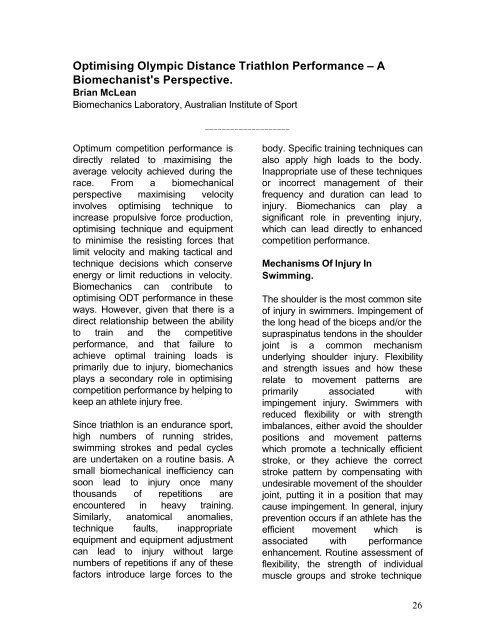MAXIMISING OLYMPIC DISTANCE TRIATHLON PERFORMANCE ...
MAXIMISING OLYMPIC DISTANCE TRIATHLON PERFORMANCE ...
MAXIMISING OLYMPIC DISTANCE TRIATHLON PERFORMANCE ...
Create successful ePaper yourself
Turn your PDF publications into a flip-book with our unique Google optimized e-Paper software.
Optimising Olympic Distance Triathlon Performance – ABiomechanist's Perspective.Brian McLeanBiomechanics Laboratory, Australian Institute of Sport____________________Optimum competition performance isdirectly related to maximising theaverage velocity achieved during therace. From a biomechanicalperspective maximising velocityinvolves optimising technique toincrease propulsive force production,optimising technique and equipmentto minimise the resisting forces thatlimit velocity and making tactical andtechnique decisions which conserveenergy or limit reductions in velocity.Biomechanics can contribute tooptimising ODT performance in theseways. However, given that there is adirect relationship between the abilityto train and the competitiveperformance, and that failure toachieve optimal training loads isprimarily due to injury, biomechanicsplays a secondary role in optimisingcompetition performance by helping tokeep an athlete injury free.Since triathlon is an endurance sport,high numbers of running strides,swimming strokes and pedal cyclesare undertaken on a routine basis. Asmall biomechanical inefficiency cansoon lead to injury once manythousands of repetitions areencountered in heavy training.Similarly, anatomical anomalies,technique faults, inappropriateequipment and equipment adjustmentcan lead to injury without largenumbers of repetitions if any of thesefactors introduce large forces to thebody. Specific training techniques canalso apply high loads to the body.Inappropriate use of these techniquesor incorrect management of theirfrequency and duration can lead toinjury. Biomechanics can play asignificant role in preventing injury,which can lead directly to enhancedcompetition performance.Mechanisms Of Injury InSwimming.The shoulder is the most common siteof injury in swimmers. Impingement ofthe long head of the biceps and/or thesupraspinatus tendons in the shoulderjoint is a common mechanismunderlying shoulder injury. Flexibilityand strength issues and how theserelate to movement patterns areprimarily associated withimpingement injury. Swimmers withreduced flexibility or with strengthimbalances, either avoid the shoulderpositions and movement patternswhich promote a technically efficientstroke, or they achieve the correctstroke pattern by compensating withundesirable movement of the shoulderjoint, putting it in a position that maycause impingement. In general, injuryprevention occurs if an athlete has theefficient movement which isassociated with performanceenhancement. Routine assessment offlexibility, the strength of individualmuscle groups and stroke technique26


